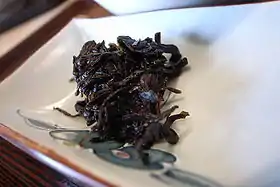Tsukudani
Tsukudani (佃煮) is small seafood, meat or seaweed that has been simmered in soy sauce and mirin.[1] As a flavorful accompaniment to plain rice, tsukidani is made salty enough to not go bad, allowing high osmotic pressure to preserve the ingredients from microbial spoilage in Japan's humid climate. Its name originates from Tsukudajima, the island (in present-day Chūō, Tokyo) where it was first made in the Edo period. Many kinds of tsukudani are sold. Traditionally made tsukudani is preservable and has been favored as a storable side dish in Japanese kitchens since the Edo period.

Tsukudani can be made with kombu or wakame seaweeds, and is often made to reuse ingredients from making dashi that would otherwise be discarded. It is usually eaten with steamed rice as a flavoring agent since the flavor is very intense (approximately 1 tbsp for one bowl of rice). Finished tsukudani is served chilled from the refrigerator, where it takes on a gelatinous texture.
Local variations
- Asari no tsukudani, made with little neck clam - Chiba Prefecture
- Ikanago no kukini (いかなごのくぎ煮), made with sand lance - Hyōgo Prefecture
- Inago no tsukudani, made with locusts - Fukushima Prefecture and Nagano Prefecture
- Zazamushi tsukudani (ざざむしの佃煮), made with stonefly and caddisfly larvae - Ina, Nagano
References
- "How to: Homemade shio kombu or kombu no tsukudani". justbento.com.
| Wikimedia Commons has media related to Tsukudani. |